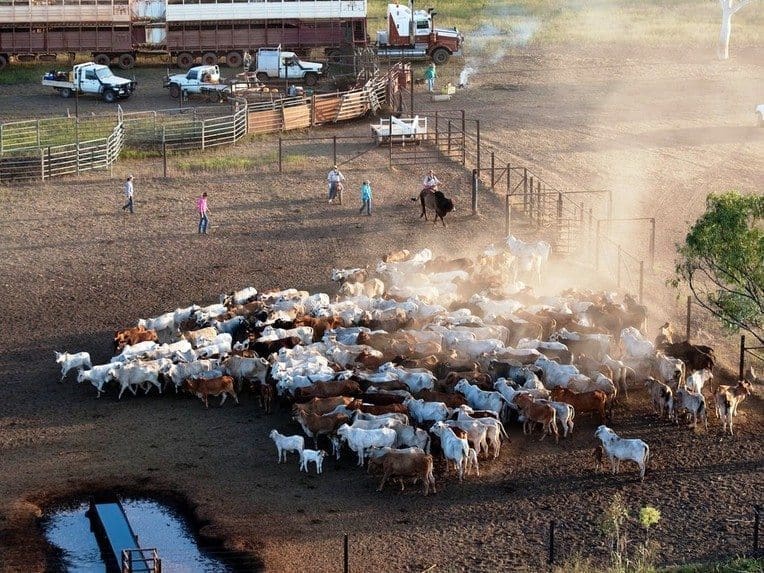
A good test for the assessment that properties boasting large cattle herds will be appealing to property buyers because of the cost of re-stocking will be the recent offering of Kalala Station near Daly Waters in the NT, being offered with 40,000 Brahman cattle.
FOREIGN and domestic entities are increasing their investment in Australian beef cattle properties, due to growing positive sentiment about cattle prices and demand, and favourable macro-economic conditions.
The latest Rural and Agribusiness Research and Forecast Report by Colliers International claims a falling exchange rate, Free Trade Agreements with major Asian partners and the over-arching driver of food security have had a discernible impact on the Australian rural property market.
A number of regions and sectors are beginning to experience growth in land values, the company says.
“Australia’s position and reputation as exporters of high quality produce has provided the catalyst for a number of significant transactions,” Colliers suggests.
This momentum is anticipated to continue into the second half of 2016, with Colliers claiming it is experiencing enquiry ‘at all levels.’
The company’s director of rural & agribusiness transaction services, Rawdon Briggs, said high confidence was fuelling interest in the beef market with demand not only from private landholders and domestic investors, but also from international investors and institutions.
“An increasing number of high net worth individuals are recognising rural Australia’s long term potential,” he said. “They are Swiss, British, Americans and Canadians. This had a significant impact upon property sales over the last year with some considerable assets exchanging hands in the last 12 months.”
Mr Briggs said there was also growing domestic interest from super funds, investment syndicates and high net worth individuals.
“I recently attended an agri-investor conference in Melbourne where there was a noticeable increase in interest among state and national-based superfunds. While they won’t have purchased directly, they are using managers to identify and understand Australian agricultural investment assets, which is an encouraging sign,” he said.
“We haven’t seen that type of interest for a long time. In the past, they have been cautiously watching foreign pension funds investing in Australian properties with beef cattle, grain, cotton, almonds and tree plantings. Now they are willing to participate.”

Colliers’ Rawdon Briggs
With cattle prices at record levels, Mr Briggs said beef properties could be seen as an attractive investment for higher-end agribusiness investors.
“Two years ago, foreign players were by the far the most dominant in the above $20m cattle property acquisitions. Today, domestic capital is the highest I’ve seen in a very long time,” he said.
As foreshadowed in last year’s Collier’s report, 2015 was a turning point for the Australian beef industry. Overall market confidence has increased substantially and resulted in the sale of a number of substantial landholdings, with expectations that these conditions will continue in the medium term.
Mr Briggs said there was a need for (seasonally) reliable property to raise cattle and this demand would positively impact medium-sized beef enterprises, depending on the region.
Stock numbers a considerable factor
Stock numbers are also expected to continue to have an effect on property sales in 2016. Mr Briggs said as supply is reduced, properties with significant stock numbers would be an attractive drawcard for potential investors.
“Given that cattle prices are at historically high levels and the national herd size is shrinking, restocking is a notable expense,” he said.
“Properties offered to the market on a walk-in, walk-out basis represent the potential to acquire a herd without the high costs associated with freight and the complexities involved in purchasing new stock. As a result properties offered with significant stock included are expected to attract significant interest.”
Mr Briggs said cattle properties with significant breeder herds would continue to attract the most investor interest.
“For instance, in the Northern Territory, stations with more than 20,000 head will be in demand, but those with above 40,000 head will be in even greater demand,” he said.
A good test for this assessment will be the recent offering of 3760sq km Kalala Station near Daly Waters in the NT, being offered through expressions of interest with 40,000 Brahman cattle through Territory Rural.
However, Mr Briggs warned that the genotype of the cattle must be aligned with the market’s requirements.
“Last week, we settled Yarra, near Gogango in Central Queensland. Unfortunately, the market saw little value in the stock on hand, and as a result, the property was sold bare for $3.75m.”
Land values tend to follow cattle prices
Mr Briggs believes the cattle market is now in a consolidation phase and property values will follow.
“There’s unlikely to be any further real upswing in beef prices. They are could fall slightly and settle at around $2.80-$3/kg, live weight,” he said.
“Land values are always a trailing indicator. If commodity prices move upward, 12 months later land values follow. We’ve seen some pretty significant transactions particularly in beef cattle properties over the last year. If we see a Kidman transaction, Australian beef cattle property sales could amount to $1.2 billion in 2016,” he predicted.
